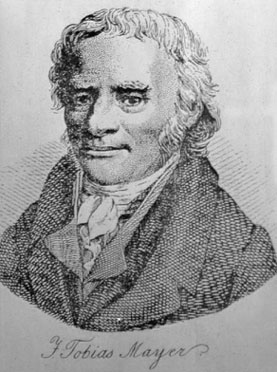| Johann Tobias Mayer  Born: 17-Feb-1723 Born: 17-Feb-1723
Birthplace: Marbach, Württemberg, Germany
Died: 20-Feb-1762
Location of death: Göttingen, Germany
Cause of death: unspecified
Gender: Male
Race or Ethnicity: White
Occupation: Astronomer Nationality: Germany
Executive summary: Kosmographische Nachrichten German astronomer, born at Marbach, in Württemberg, on the 17th of February 1723, and brought up at Esslingen in poor circumstances. A self-taught mathematician, he had already published two original geometrical works when, in 1746, he entered J. B Homann's cartographic establishment at Nuremberg. Here he introduced many improvements in mapmaking, and gained a scientific reputation which led (in 1751) to his election to the chair of economy and mathematics in the University of Göttingen. In 1754 he became superintendent of the observatory, where he labored with great zeal and succes until his death, on the 20th of February 1762. His first important astronomical work was a careful investigation of the libration of the moon (Kosmographische Nachrichten, Nuremberg 1750), and his chart of the full moon (published in 1775) was unsurpassed for half a century. But his fame rests chiefly on his lunar tables, communicated in 1752, with new solar tables to the Royal Society of Göttingen, and published in their Transactions. In 1755 he submitted to the English government an amended body of manuscript tables, which James Bradley compared with the Greenwich observations, and found to be sufficiently accurate to determine the moon's place to 75", and consequently the longitude at sea to about half a degree. An improved set was afterwards published in London (1770), as also the theory (Theoria lunae juxta systema Newtonianum, 1767) upon which the tables are based. His widow, by whom they were sent to England, received in consideration from the British government a grant of £3000. Appended to the London edition of the solar and lunar tables are two short tracts -- the one on determining longitude by lunar distances, together with a description of the repeating circle (invented by Mayer in 1752), the other on a formula for atmospheric refraction, which applies a remarkably accurate correction for temperature.
Mayer left behind him a considerable quantity of manuscript, part of which was collected by G. C. Lichtenberg and published in one volume (Opera inedita, Göttingen, 1775). It contains an easy and accurate method for calculating eclipses; an essay on color, in which three primary colors are recognized; a catalogue of 998 zodiacal stars; and a memoir, the earliest of any real value, on the proper motion of eighty stars, originally communicated to the Göttingen Royal Society in 1760. The manuscript residue includes papers on atmospheric refraction (dated 1755), on the motion of Mars as affected by the perturbations of Jupiter and the Earth (1756), and on terrestrial magnetism (1760 and 1762). In these last Mayer sought to explain the magnetic action of the earth by a modification of Leonhard Euler's hypothesis, and made the first really definite attempt to establish a mathematical theory of magnetic action (C. Hansteen, Magnetismus der Erde, i.283). E. Klinkerfuss published in 1881 photo-lithographic reproductions of Mayer's local charts and general map of the moon; and his star catalogue was re-edited by Francis Baily in 1830 (Memoirs Roy. Astr. Soc. iv. 391) and by G. F. J. A. Auvers in 1894.
Professor: University of Göttingen
Do you know something we don't?
Submit a correction or make a comment about this profile
Copyright ©2019 Soylent Communications
|